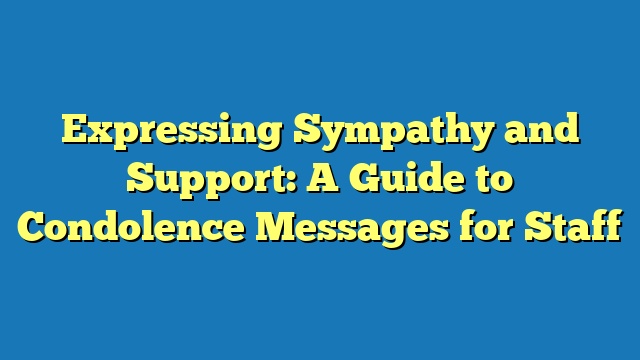A condolence message to staff is an expression of sympathy and support sent to employees who have experienced a loss or setback. For example, a company might send a condolence message to the family of an employee who has passed away.
Condolence messages to staff can play an important role in supporting employees during difficult times. They can help employees feel seen, heard, and valued. In addition, they can help to create a positive and supportive work environment.
The practice of sending condolence messages to staff has a long history. In the past, condolence messages were often sent in the form of letters or telegrams. Today, they are more likely to be sent via email or text message.
Condolence Message to Staff
Condolence messages to staff play a crucial role in supporting employees during difficult times. They help employees feel seen, heard, and valued, and can create a positive and supportive work environment.
- Empathy
- Support
- Respect
- Confidentiality
- Timeliness
- Personalization
- Brevity
- Sincerity
Empathy is essential in a condolence message, as it allows the sender to understand and share the feelings of the recipient. Support is also important, as it shows the recipient that they are not alone. Respect is important in acknowledging the recipient’s loss and their need for space. Confidentiality is important in maintaining the privacy of the recipient. Timeliness is important in sending the message promptly, so that the recipient knows that they are being thought of. Personalization is important in making the message unique and meaningful to the recipient. Brevity is important in keeping the message concise and to the point. Sincerity is important in conveying genuine sympathy and support.
Empathy
Empathy is a crucial aspect of a condolence message to staff, as it allows the sender to understand and share the feelings of the recipient. This is important because it helps the recipient feel seen, heard, and valued.
-
Understanding the recipient’s perspective
This involves putting oneself in the recipient’s shoes and trying to understand their thoughts and feelings. For example, if the recipient has lost a loved one, the sender might try to imagine what it would be like to lose someone close to them. -
Sharing the recipient’s emotions
This involves expressing sympathy and support for the recipient. For example, the sender might say something like, “I’m so sorry for your loss” or “I’m here for you if you need anything.” -
Respecting the recipient’s boundaries
This involves giving the recipient space and time to grieve. For example, the sender might say something like, “I’m here for you if you want to talk, but I understand if you need some time alone.” -
Being genuine
This involves expressing sympathy and support in a sincere and heartfelt way. For example, the sender might say something like, “I’m so sorry for your loss. I can’t imagine what you must be going through.”
Empathy is an essential part of a condolence message to staff. By understanding the recipient’s perspective, sharing their emotions, respecting their boundaries, and being genuine, the sender can provide much-needed support during a difficult time.
Support
Support is a critical component of a condolence message to staff. It shows the recipient that they are not alone and that there are people who care about them. Support can take many forms, such as offering practical help, listening to the recipient’s concerns, or simply being there for them.
Offering practical help can be a meaningful way to show support. For example, the sender might offer to help with errands, childcare, or meals. Listening to the recipient’s concerns can also be helpful, as it allows them to express their feelings and process their grief. Simply being there for the recipient can also be a powerful form of support. This could involve spending time with them, talking to them on the phone, or sending them a text message to let them know that you are thinking of them.
Support is essential for helping employees cope with a loss. By providing support, employers can create a positive and supportive work environment that can help employees heal and move forward.
Respect
Respect is a cornerstone of a condolence message to staff. It involves acknowledging the recipient’s loss, their need for space, and their right to grieve in their own way.
-
Privacy
Respecting the recipient’s privacy means giving them space and time to grieve. This may mean avoiding contacting them too often or asking them how they are doing. It also means respecting their decision if they do not want to talk about their loss. -
Boundaries
Respecting the recipient’s boundaries means understanding that they may need some time alone. It also means respecting their decision if they do not want to talk about their loss. It is important to give them space and time to grieve in their own way. -
Culture
Respecting the recipient’s culture means being aware of their cultural beliefs and practices surrounding death and grief. This may include understanding their religious beliefs, their customs, and their traditions. -
Individuality
Respecting the recipient’s individuality means recognizing that everyone grieves differently. There is no right or wrong way to grieve. It is important to be patient and understanding, and to allow the recipient to grieve in their own way.
Respect is essential for creating a supportive and compassionate environment for grieving employees. By respecting the recipient’s privacy, boundaries, culture, and individuality, employers can show that they care and that they are there to support them.
Confidentiality
Confidentiality is an essential aspect of a condolence message to staff. It involves respecting the privacy of the recipient and their right to grieve in their own way. Maintaining confidentiality can help to create a safe and supportive environment for grieving employees.
-
Privacy
Privacy is the right of the recipient to keep their personal information and grief private. This means that the sender should not share the recipient’s information with others without their consent.
-
Respect
Respecting the recipient’s privacy means giving them space and time to grieve. This may mean avoiding contacting them too often or asking them how they are doing. It also means respecting their decision if they do not want to talk about their loss.
-
Trust
Trust is essential for creating a safe and supportive environment for grieving employees. When employees trust that their privacy will be respected, they are more likely to share their feelings and concerns. This can help them to heal and move forward.
-
Ethics
Maintaining confidentiality is also an ethical obligation. It is important to protect the privacy of grieving employees and to avoid causing them any further harm.
Confidentiality is an important part of a condolence message to staff. By respecting the recipient’s privacy, employers can create a safe and supportive environment for grieving employees.
Timeliness
Timeliness is an important aspect of a condolence message to staff. It is a sign of respect and support, and it can help the recipient to feel seen and valued.
-
Promptness
Sending a condolence message promptly shows the recipient that you are thinking of them and that you care. It can also help them to feel less alone during a difficult time. -
Respecting the recipient’s time
When sending a condolence message, it is important to be respectful of the recipient’s time. This means being concise and to the point, and avoiding sending messages at inappropriate times, such as late at night or early in the morning. -
Consideration for cultural differences
When sending a condolence message to someone from a different culture, it is important to be aware of any cultural differences that may affect the timeliness of your message. For example, in some cultures it is considered disrespectful to send a condolence message too soon after the death of a loved one. -
Following up
It is often a good idea to follow up with the recipient of a condolence message after a few days or weeks to see how they are doing. This shows that you are still thinking of them and that you are there for them if they need anything.
Timeliness is an important part of a condolence message to staff. By being timely, you can show the recipient that you care and that you are there to support them.
Personalization
Personalization is a critical component of a condolence message to staff. It shows the recipient that you care about them and that you are taking the time to acknowledge their individual loss. A personalized message can be more meaningful and comforting than a generic one.
There are many ways to personalize a condolence message. One way is to include the recipient’s name in the message. Another way is to mention something specific about the person who died. For example, you could say something like, “I remember how much your father loved to spend time with his grandchildren.” You could also share a memory of the person who died. For example, you could say something like, “I remember the time your mother made us all laugh when she told us about the time she got lost in the woods.”
Personalizing a condolence message can take a little extra time, but it is worth it. A personalized message will show the recipient that you care and that you are there for them during this difficult time.
Brevity
Brevity is a crucial component of a condolence message to staff. A concise message is more likely to be read and appreciated by the recipient. It also shows respect for the recipient’s time and attention.
There are several reasons why brevity is important in a condolence message to staff. First, people who are grieving are often overwhelmed with emotions. They may not have the time or energy to read a long message. Second, a brief message is less likely to be misunderstood. When people are grieving, they may be more sensitive to the words that are used. A brief message can help to avoid any potential misunderstandings.
Here are some tips for writing a brief condolence message to staff:
Keep it short and to the point. Your message should be no more than a few sentences long. Use simple language. Avoid using jargon or technical terms. Be sincere. Your message should come from the heart. Offer support. Let the recipient know that you are there for them if they need anything.
Here is an example of a brief condolence message to staff:
>Dear [Recipient’s name],>I am so sorry to hear about the loss of your [relationship to the deceased]. Please accept my deepest condolences.>I know that this is a difficult time for you and your family. I want you to know that I am here for you if you need anything.>Sincerely,>[Your name]By following these tips, you can write a brief and meaningful condolence message to staff that will be appreciated by the recipient.
Sincerity
In the realm of condolence messages to staff, sincerity stands as a cornerstone, imbuing these expressions of sympathy with a profound sense of authenticity and genuine care. By embracing sincerity, we honor the memory of the departed while providing invaluable support to those who grieve.
-
Empathetic Understanding
Sincerity manifests through an empathetic understanding of the recipient’s pain. By acknowledging their loss and expressing genuine sorrow, we create a space where they feel heard and supported. -
Thoughtful Personalization
A sincere message is tailored to the individual recipient. This involves incorporating personal anecdotes, shared memories, or specific qualities of the deceased, demonstrating that we have taken the time to reflect on their unique bond. -
Honest Expression
Sincerity demands that our words come from the heart. Avoid clichd phrases or generic platitudes. Instead, express your condolences in a genuine and heartfelt manner, allowing your true emotions to shine through. -
Appropriate Tone
The tone of a sincere message is respectful and compassionate. While it is important to convey sympathy, it is equally crucial to maintain a professional and appropriate demeanor, avoiding excessive emotionalism or insensitivity.
By adhering to these principles of sincerity, we can craft condolence messages to staff that truly resonate, offering solace and support during a time of profound loss. In doing so, we not only honor the memory of the departed but also foster a compassionate and supportive workplace environment.
FAQs on Condolence Messages to Staff
This FAQ section addresses common questions and clarifies aspects related to condolence messages to staff, offering guidance on appropriate etiquette and effective communication during times of loss.
Question 1: What is the purpose of sending a condolence message to staff?
Answer: A condolence message expresses sympathy and support to employees who have experienced a loss, fostering a caring and compassionate work environment.
Question 2: What are the key elements of a sincere condolence message?
Answer: A sincere message acknowledges the loss, offers genuine empathy, and is tailored to the individual recipient, demonstrating a thoughtful understanding of their grief.
Question 3: How can I personalize a condolence message?
Answer: Personalization involves incorporating specific details, such as shared memories, unique qualities of the deceased, or anecdotes that resonate with the recipient’s bond with the departed.
Question 4: Is it appropriate to offer practical support in a condolence message?
Answer: Yes, offering practical assistance, such as help with errands, childcare, or meals, can be a meaningful way to demonstrate support and alleviate some of the burdens faced by grieving employees.
Question 5: How should I handle cultural differences when sending a condolence message?
Answer: Be mindful of cultural variations in mourning practices and expressions of sympathy. Research or consult with colleagues to ensure your message is culturally appropriate and respectful.
Question 6: What is the appropriate length for a condolence message?
Answer: While brevity is appreciated, the length of the message should allow for genuine expression of sympathy. Aim for a few heartfelt sentences that convey your condolences and support.
These FAQs provide essential guidance on crafting meaningful and supportive condolence messages to staff. By adhering to these principles, we can create a workplace culture that values compassion, empathy, and the well-being of our colleagues during times of loss.
In the next section, we will delve deeper into the nuances of condolence messages, exploring strategies for effective communication and the role of empathy in supporting grieving employees.
Tips for Writing Condolence Messages to Staff
Crafting a heartfelt condolence message to a staff member who has experienced a loss is a delicate task that requires empathy, respect, and sincerity. Here are some practical tips to guide you in expressing your sympathy and support:
Tip 1: Personalize the Message:Acknowledge the recipient’s unique connection to the deceased by mentioning shared experiences or specific qualities of the departed.Tip 2: Offer Specific Support:In addition to expressing your condolences, offer practical assistance such as help with tasks, errands, or meals to alleviate some of the burdens during this difficult time.Tip 3: Respect Cultural Differences:Be mindful of cultural variations in mourning practices and expressions of sympathy. Research or consult with colleagues to ensure your message is culturally appropriate.Tip 4: Maintain a Professional Tone:While empathy is crucial, it’s essential to maintain a professional and respectful tone in your message. Avoid excessive emotionalism or using overly personal language.Tip 5: Keep it Brief and Sincere:Your message should be concise and heartfelt, allowing the recipient to feel your genuine sympathy without overwhelming them with lengthy text.Tip 6: Proofread Carefully:Before sending your message, proofread it carefully to ensure there are no errors in grammar or spelling that could detract from the sincerity of your words.Tip 7: Send a Physical Card:In addition to an email or electronic message, consider sending a physical card or note to express your condolences in a tangible way.
By following these tips, you can create meaningful and supportive condolence messages that demonstrate your empathy, respect, and genuine concern for your colleagues during this time of loss.
These practical tips lay the foundation for effective communication and support when sending condolence messages to staff. In the final section of this article, we will explore the importance of empathy in supporting grieving employees and how to create an inclusive and supportive workplace environment.
Conclusion
Condensation announcements to staff play a critical role in supporting employees during difficult times. They provide a means of expressing sympathy, offering aid, and upholding a caring and compassionate workplace environment. This article has delved into the nuances of condolence messages, providing practical tips and guidance on crafting meaningful and supportive messages that resonate with the recipient’s grief.
Key points to consider include: personalizing the message to acknowledge the unique bond between the recipient and the deceased, offering specific forms of support to alleviate practical burdens, and maintaining a professional and respectful tone while conveying genuine empathy. By adhering to these principles, we can create a culture of compassion and support, allowing grieving employees to feel seen, heard, and valued during their time of loss.









Tips for Using "Template by Kevin Crafts" Comments for Meaningful Online Discussions